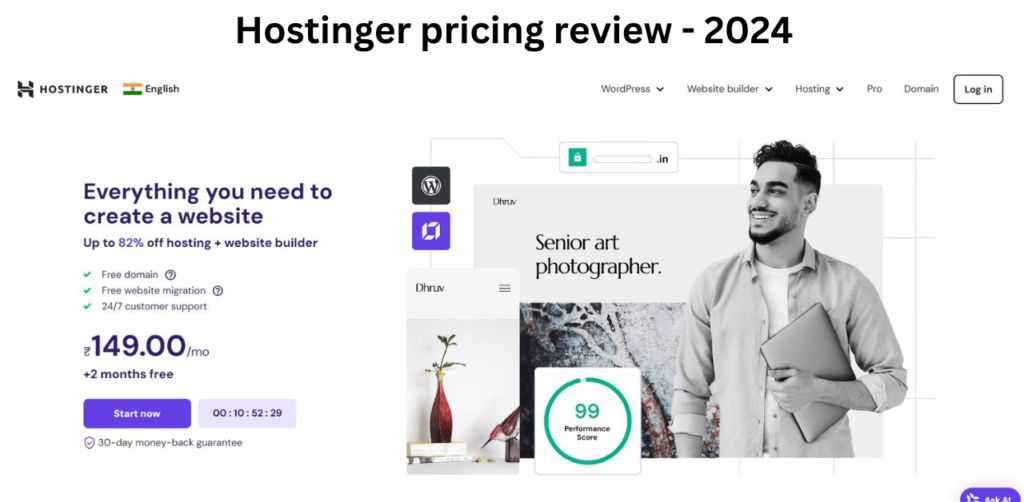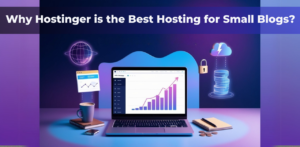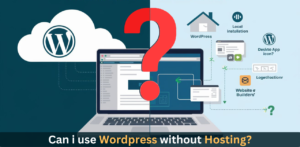Table of Contents
ToggleThe Difference between blog and article in SEO | 75% OFF on Hostinger Hosting – Take a Look Now!
Seth Godin, a well-known author and marketer, once said, “Content marketing is the only marketing left.”
Today, blogs and articles are often confused with each other. But they have different qualities that affect their SEO performance.
In this article, we’ll explore the differences between blogs and articles. We’ll see how these differences shape their roles in content strategy.
By understanding these differences, you can create content that engages your audience and improves your website’s search engine ranking.
Understanding the Basics
Before diving into the SEO implications, let’s clarify what we mean by blogs and articles.
What is a Blog?
A blog, short for “weblog,” is a type of website or a section of a website that features regularly updated content in a more informal, conversational style.
Blogs originated in the late 1990s as online personal diaries but have since evolved into powerful communication tools for individuals, businesses, and organizations.
Key characteristics of a blog include:
- Informal and conversational in tone: Blogs often use a personal voice, making them more relatable and engaging for readers.
- Frequent updates: Blogs are typically updated regularly, whether daily, weekly, or monthly, providing fresh content for readers and search engines.
- Reverse chronological order: The most recent posts appear first, making it easy for regular readers to stay up-to-date.
- Interactive nature: Blogs usually allow comments, fostering discussion and community engagement.
- Diverse content types: While often text-based, blogs can include images, videos, infographics, and other multimedia elements.
- Categorization and tagging: Blog posts are often organized into categories and tagged with relevant keywords for easy navigation.
- RSS feeds: Many blogs offer RSS (Really Simple Syndication) feeds, allowing readers to subscribe and receive updates automatically.
Blogs can cover a wide range of topics, from personal experiences and opinions to industry news, how-to guides, and company updates.
They serve as a versatile platform for sharing information, building brand awareness, and establishing thought leadership in a particular niche.
What is an Article?
An article is a piece of writing that provides information, analysis, or interpretation on a specific topic.
Unlike blogs, articles tend to have a more formal structure and tone, often adhering to journalistic or academic standards.
Key characteristics of an article include:
- Formal and structured: Articles typically follow a more rigid structure, with a clear introduction, body, and conclusion.
- Comprehensive coverage: Articles aim to provide in-depth information on a topic, often including research, data, and expert opinions.
- Objective tone: While opinion pieces exist, many articles strive for objectivity, presenting balanced viewpoints and factual information.
- Evergreen content: Articles are often designed to remain relevant for an extended period, providing long-term value to readers.
- Length variation: Articles can range from short pieces of a few hundred words to long-form content of several thousand words, depending on the topic and publication.
- Fact-checking and editing: Articles usually undergo a more rigorous editing process to ensure accuracy and clarity.
- Citations and references: Especially in academic or scientific articles, proper citation of sources is crucial.
- Less frequent updates: Unlike blogs, articles are typically published as standalone pieces and are not regularly updated (though they may be revised for accuracy over time).
Articles can appear in various contexts, including newspapers, magazines, academic journals, and websites.
They serve to inform, educate, or persuade readers on specific subjects, often targeting a more focused audience than blogs.
SEO Implications of Blogs vs Articles
When it comes to SEO, both blogs and articles can be powerful tools, but they serve different purposes and require different strategies.
SEO Benefits of Blogs
- Fresh Content: Search engines love websites that are regularly updated. Blogs, with their frequent posts, signal to search engines that your site is active and current.
- Long-Tail Keywords: Blog posts often target long-tail keywords naturally, which can help attract niche audiences and improve overall search visibility.
- Internal Linking: A blog structure makes it easy to interlink related posts, improving site navigation and distributing page authority.
- Social Sharing: The informal nature of blogs makes them more shareable on social media, potentially increasing backlinks and social signals.
SEO Benefits of Articles
- In-Depth Coverage: Articles typically provide comprehensive information on a topic, which can position your site as an authoritative source.
- Evergreen Content: Well-written articles can remain relevant for years, continuously attracting traffic and potentially earning backlinks over time.
- E-E-A-T Signals: Detailed, well-researched articles can improve your site’s Experience, Expertise, Authoritativeness, and Trustworthiness (E-E-A-T) in the eyes of search engines.
- Featured Snippets: The structured nature of articles makes them more likely to be featured in Google’s featured snippets or “position zero” results.
Content Strategy: When to Use Blogs vs Articles
Choosing between a blog post and an article depends on your content goals and target audience. Here’s a quick comparison:
| Blogs | Articles |
|---|---|
| Flexible and spontaneous | Structured and comprehensive |
| Responsive to current trends | Involves extensive research |
| Conversational tone | Informative and in-depth |
| Frequent updates | Focused on authority and thought leadership |
Knowing the differences between blogs and articles is key. By using both, businesses can create a strong content strategy.
This strategy engages the audience and boosts digital marketing success.
Best Practices for SEO-Friendly Blogs & Articles
Creating SEO-friendly content goes beyond just incorporating keywords.
It’s about providing value to your readers while also making your content easily discoverable and understandable for search engines.
1. Keyword Research: Start by conducting thorough keyword research to identify relevant terms and phrases that your target audience is searching for.
However, avoid keyword stuffing; instead, focus on naturally integrating these keywords into your content.
2. Quality Content: Quality should always be your top priority. High-quality, informative content is more likely to earn backlinks and social shares, which are crucial factors in SEO.
Strive to create comprehensive pieces that answer your readers’ questions and solve their problems.
This approach not only satisfies search engines but also builds trust with your audience.
3. Proper Formatting: Proper formatting is essential for both readability and SEO. Use headers (H1, H2, H3) to structure your content logically.
This hierarchy helps readers navigate your content easily and allows search engines to understand the relationship between different sections of your text.
Break up long paragraphs into shorter, more digestible chunks, and use subheadings to guide readers through your content.
4. Meta Descriptions: Meta descriptions play a crucial role in attracting clicks from search engine results pages.
Write compelling meta descriptions that accurately summarize your content and include your target keyword.
Keep them under 160 characters to ensure they display properly in search results.
A well-crafted meta description can significantly improve your click-through rates, indirectly benefiting your SEO.
5. Image Optimization: Don’t overlook the importance of image optimization. Use relevant images to break up text and illustrate your points.
Optimize these images by compressing them for faster load times, using descriptive file names, and including alt text.
6. Alt text: Alt text not only improves accessibility for visually impaired users but also provides context for search engines, potentially helping your images appear in image search results.
7. Internal linking: Internal linking is another powerful SEO tactic. By linking to other relevant pages on your site, you help search engines understand the structure of your website and the relationships between different pieces of content.
This can improve the overall SEO performance of your site. However, ensure that your internal links are natural and provide value to the reader, rather than just linking for the sake of SEO.
Best Practices for SEO-Friendly Blogs & Articles
To truly understand the impact of your blogs and articles on your SEO efforts, you need to dive deep into analytics.
Start by monitoring your organic traffic, which indicates how many visitors are finding your content through search engines.
Look for trends over time – are certain types of content consistently attracting more organic traffic? This can guide your future content strategy.
Time on page is another crucial metric. It indicates how engaging your content is – are people actually reading what you’ve written, or are they quickly bouncing away? A high time on page suggests that your content is relevant and valuable to your audience.
However, interpret this metric in context; a lower time on page isn’t always negative, especially if your content quickly and efficiently answers the user’s query.
Bounce rate can provide insights into whether your content meets user expectations.
A high bounce rate might indicate that your content isn’t matching what users expected to find based on your title or meta description.
However, like time on page, bounce rate should be interpreted carefully. A high bounce rate isn’t always bad, especially if your content quickly satisfies the user’s need.
Tracking backlinks is crucial for understanding your content’s authority and reach. High-quality backlinks from reputable sites can significantly boost your SEO.
Use tools like Ahrefs, Moz, or SEMrush to monitor your backlink profile. Pay attention not just to the quantity of backlinks, but also to their quality and relevance.
Social shares, while not a direct ranking factor, can indicate your content’s popularity and can lead to increased visibility and potential backlinks.
Monitor which pieces of content are being shared most frequently on social media platforms.
This can provide insights into what types of content resonate most with your audience.
Finally, keep a close eye on your keyword rankings. Are your target keywords improving in search engine results pages (SERPs)? Tools like Google Search Console can provide valuable data on which queries are bringing users to your site.
Use this information to refine your content strategy and identify new opportunities for optimization.
The Future of Blogs and Articles in SEO
As search engines continue to evolve, so too must our approach to creating and optimizing blogs and articles.
One of the most significant trends shaping the future of SEO is the rise of voice search.
With the increasing popularity of virtual assistants like Siri, Alexa, and Google Assistant, optimizing for conversational, long-tail keywords will become even more crucial.
This shift may blur the lines between blogs and articles further, as content will need to answer specific questions in a natural, conversational tone.
Mobile-first indexing is another trend that will continue to shape SEO strategies.
With Google now primarily using the mobile version of content for indexing and ranking, ensuring that your blogs and articles are mobile-friendly is no longer optional.
This means focusing on responsive design, fast loading times, and easy-to-read content on smaller screens.
The integration of video and multimedia content into blogs and articles is likely to become more prevalent.
As search engines become better at understanding and indexing video content, incorporating relevant videos into your written content could provide SEO benefits.
This might lead to a hybrid form of content that combines the best elements of blogs, articles, and video.
Artificial Intelligence (AI) is set to play a larger role in content creation and SEO.
While AI-generated content is already a reality, it’s likely to become more sophisticated and widespread.
This could change how we approach content creation, potentially allowing for more personalized content at scale.
However, the human touch in content creation will remain crucial for providing unique insights and maintaining authenticity.
The concept of E-E-A-T (Experience-Expertise, Authoritativeness, and Trustworthiness) is likely to gain even more importance in the future of SEO.
Search engines are getting better at understanding the quality and credibility of content.
This means that establishing your expertise through well-researched, in-depth content will be more important than ever, regardless of whether you’re writing blogs or articles.
Choosing the Right Hosting Platform for Your Content

Whether you’re focusing on blogs, articles, or a mix of both, having a reliable hosting platform is crucial for your SEO success.
One platform that stands out for its features and benefits is Hostinger.
Why Choose Hostinger for Your Blogs and Articles?
Hostinger offers a range of features that can significantly enhance your SEO efforts:
- Fast Loading Speed: With LiteSpeed Web Server and optimized WordPress hosting, Hostinger ensures your content loads quickly, a crucial factor for both user experience and SEO.
- Free SSL Certificates: Secure your site with free SSL, boosting your search engine rankings and protecting your visitors’ data.
- User-Friendly Interface: Easy-to-use control panel and one-click WordPress installation make it simple to set up and manage your content.
- Affordable Plans: Competitive pricing allows you to invest more in content creation and marketing rather than hosting costs.
- 24/7 Customer Support: Get help whenever you need it, ensuring your site stays up and running.
- Regular Backups: Protect your content with automated backups, giving you peace of mind and safeguarding your SEO efforts.
- SEO Toolkit: Access built-in SEO tools to optimize your content and improve your search engine rankings.
By choosing Hostinger, you’re not just getting a hosting provider; you’re gaining a partner in your SEO journey.
Their robust infrastructure and SEO-friendly features provide the foundation you need to create, publish, and promote high-quality blogs and articles that perform well in search engine results.
Conclusion
Understanding the differences between blogs and articles in SEO is crucial for developing a comprehensive content strategy.
While blogs offer freshness and engagement, articles provide depth and authority.
By leveraging both formats effectively and hosting your content on a reliable platform like Hostinger, you can create a powerful SEO strategy that drives organic traffic and establishes your online presence.
Remember, the key to SEO success lies not just in understanding the technical differences between content types, but in consistently creating valuable, user-focused content that answers your audience’s questions and solves their problems.
Frequently Asked Questions
A: Absolutely! Many successful websites use a combination of blogs and articles to cater to different audience needs and SEO goals.
A: While there’s no one-size-fits-all answer, generally, blog posts can be anywhere from 300-1500 words, while articles are often 1500 words or more. The key is to cover the topic comprehensively without unnecessary fluff.
A: Consistency is more important than frequency. Whether it’s once a week or once a month, establish a regular publishing schedule you can maintain.
A: While expertise helps, thorough research and accurate information are most important. If you’re not an expert, consider interviewing experts or citing authoritative sources in your articles.
A: Include eye-catching images, write compelling headlines, and create content that provides value to your target audience. Also, make sure to include easy-to-use social sharing buttons on your website.







